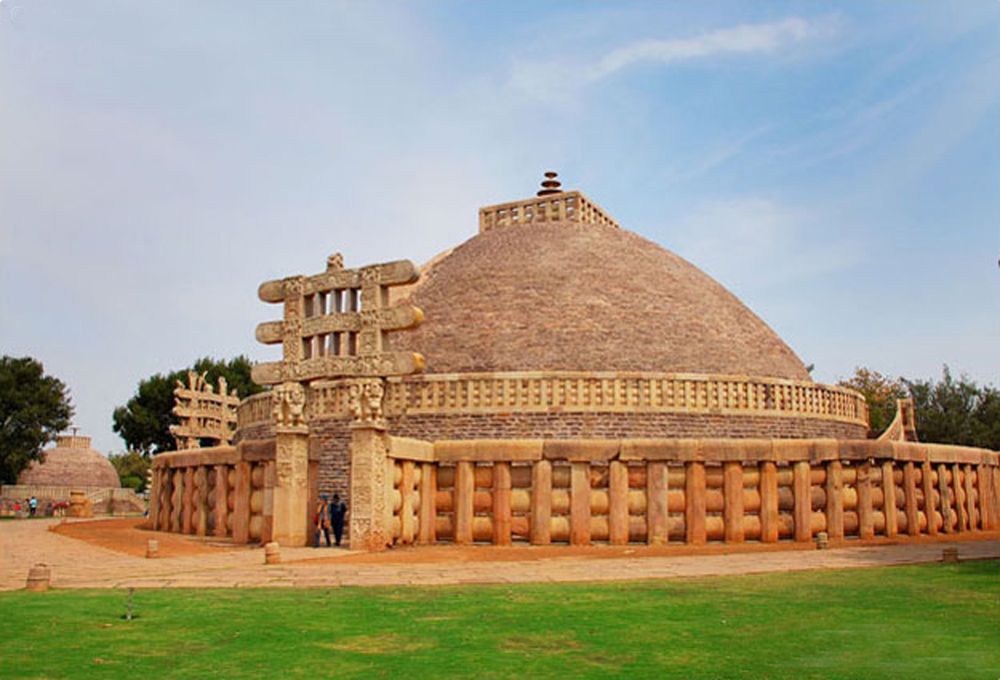Sanchi, in Madhya Pradesh, is world famous for the ruins of stupas, temples, and monasteries that lie scattered across a lonely hill. It is the largest and oldest Buddhist sanctuary in India.
The stupa was originally a burial or reliquary mound, but later became a purely symbolic structure. In the beginning, stupas were built over the relics of Lord Buddha. Later, the Emperor Ashoka built over 84,000 stupas. The Great Stupa at Sanchi is one of the oldest in India.
Sanchi continued to flourish after the Mauryas, through several later dynasties. Magnificent gateways were constructed by successive rulers, four images of Buddha were added, and more monasteries and temples were built. With the gradual disappearance of Buddhism from India, the ruins of Sanchi lay forgotten, until they were discovered by an Englishman, General Tylor, in 1818.
Why is the Great Stupa of Sanchi of great significance ?
The best known, and most elaborate amongst the stupas at Sanchi is the Great Stupa. It is part of an entire complex of structures, mostly stupas, built between the 3rd century BC and the 12th century AD. The stupa evolved from being a structure built over the relics of Buddha and his followers, to a symbol of the Buddha himself. More exactly, it became a symbol of his final release from the cycle of birth and rebirth. The Great Stupa, like other stupas, is a hemispherical dome. Its hemispherical shape represents the world egg. Stupas commonly rest on a square pedestal, and are carefully aligned with the four cardinal points of the compass. The Great Stupa has a three tired umbrella or parasol on top. The so-called ‘parasols’, set one above the other, along the shaft emerging from its uppermost region, represent a heavenly hierarchy.
The Great Stupa of Sanchi is the oldest stone structure in India. It was commissioned by the Emperor Ashoka the Great in the 3rd century BC. It underwent a complete reconstruction after wanton damage inflicted upon it in the middle of the second century BC. The reconstruction consisted of a stone casting, balustrades, a paved processional path and an umbrella and railing. Four elaborately carved gateways were added in the first century BC.
From Pillar to Press
The Ashoka Pillar at Sanchi is a beautifully proportioned structure. After the discovery of the ruins by General Tylor in 1818, there was a mad scramble to unearth more relics, and many of the monuments were found to be badly damaged. In fact, the Ashoka Pillar was being used by a local landowner as a sugarcane press!
Other Stupas
The hillside at Sanchi is scattered with many stupas, both big and small. There is a stupa known as Stupa 2, which today consists only of a carved balustrade. The stupa known as Stupa 3 has relics inside large stone boxes that were discovered by the archaeologist Sir Alexander Cunningham. The Sanchi stupas are noteworthy for their gateways, as they contain ornamental depictions of incidents from the life of the Buddha and his previous incarnations.
Udaygiri Caves
The Udaygiri Caves are situated about 13 kilometers from Sanchi. Udaygiri is a Sanskrit word meaning ‘sunrise hill’. The Udaygiri caves are a group of rock-cut cave sanctuaries carved into a sandstone hill that stands sentinel-like on the horizon. An inscription in one of these caves states that it was carved during the reign of Chandragupta II.
























